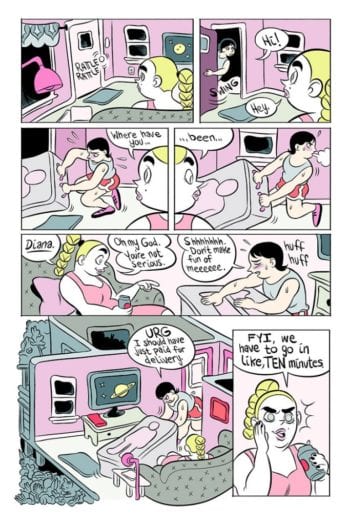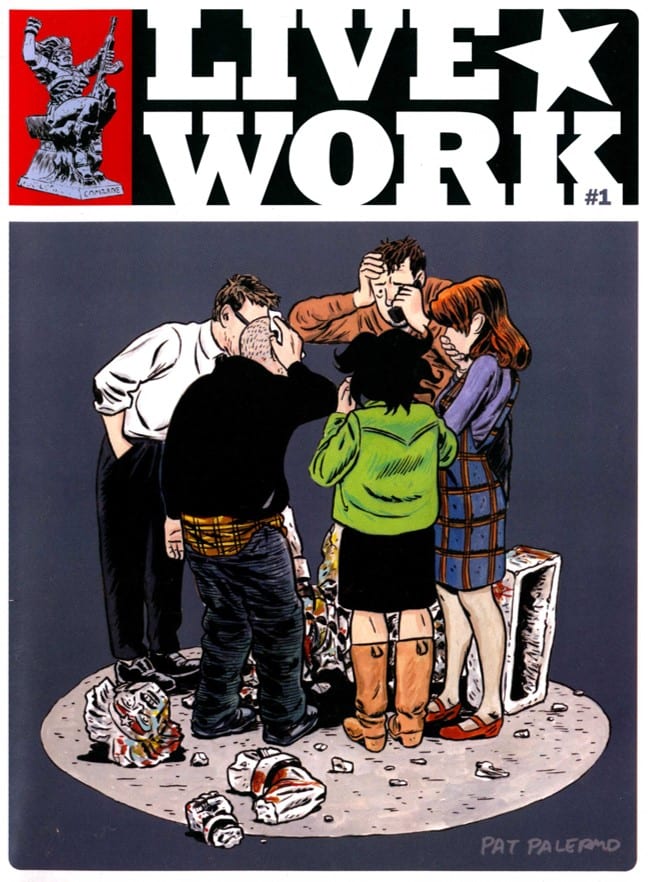Carolyn Nowak has previously won Ignatzes for Promising New Talent (“Radishes,” 2016) and Outstanding Story (“Diana’s Electric Tongue,” 2017). These categories are apt summaries of her latest book Girl Town: good stories suggestive of an ascending talent. Carta Monir writes in Girl Town’s Foreword, “Carolyn Nowak’s work is all about women who are looking for connection, validation, and fulfillment. Women who are painfully jealous, and full of more feelings than they know what to do with. Women whose friendships with other women are their lifeline.” Each comic–this book collects five comic shorts–focuses on a female character’s experience in the world, although these are not “women’s issues” narratives, whatever that label may designate. The quandaries Nowak explores are universal regardless of gender: questions of friendship, belonging, knowing one’s self, and the search for meaning.
In this way Girl Town is characterized by what its back cover describes as Nowak’s ability to “capture the spirit of our time.” Each included comic explores the human longing for connection amidst an ever increasingly technological age faced with the inverse decline of real-world social capital. “Diana’s Electric Tongue” portrays this most literally in that Diana purchases a robot lover to cope with the termination of a significant relationship. In other comics, the connection to technological development is less overt, even non-existent, but the undergirding cultural tenor of felt isolation despite increased potential for social connectivity remains. Nowak’s protagonists stand in the grips of harrowing emotional solitude. All attempt, and some succeed, to find connection with both an internal self and others by learning to love and let themselves be loved in return. This emphasis on self-love combined with the yearning for unconditional acceptance in the face of emotional insulation stands as a hallmark of the millennial zeitgeist. Nowak’s ability for capturing this generational spirit may be her chief appeal.

By contrast, her art is possibly one of the less memorable aspects of Girl Town. Nowak is by no means a poor artist. Each of Girl Town’s five included comics exists within a different genre illustrated via an alternate aesthetic. The introductory comic, being a woman’s internal monologue processing her crush on her neighbor, consists of pastel violet cartoon sketches. “Radishes,” a magical realist tale about two friends’ day of hooky at a fantastical amusement park, faintly recalls Nowak’s prior art for the ongoing comic Lumberjanes. “Diana’s Electric Tongue,” the collection’s longest comic, is a sci-fi story illustrated through strong curvaceous lines and a vibrant palette. The concluding pseudo-ghost narrative, “Please Sleep Over,” retains the wavy lines of its two preceding comics while infusing a rough hatching for backgrounds and scenery.
These comic short stories are well crafted, but that is all they are. Criticizing an artist for being good is, admittedly, a peculiar critique. The problem is that Nowak’s art and design are not adventurous in how they utilize or play with the comics form. Nowak possesses an evident artistic aptitude. One would like to see this talent put towards exploring the limits of the comics medium (not to mention developing a characteristic style). For example, how can panels, gutters, or page layouts be manipulated to further Nowak’s point of view? Given this intentional lens, how might she develop an écriture féminine unique to comics? Can the panel’s innate separateness be utilized to reflect the solitude expressed by Nowak’s characters? Despite its use of multiple genres and styles, Girl Town follows a largely standard comics layout.
The exception to this is Nowak’s penultimate comic, “The Big Burning House.” Being the transcribed monologue of a podcast between two friends discussing a fictitious movie, this comic consists largely of free-floating word balloons containing the friends’ dialogue interspersed with drawn webpages and screenshots from the film in question, as well as memories belonging to the bantering characters. Even with these interstitial visuals, Nowak’s design pictorially recreates a podcast’s auditory experience. The word balloons without bodily origin mimic a podcast’s disembodied voices, while the balloons’ codified colors optically manifest the audible distinction between voices resulting from pitch or accent. Further, in presenting disparate, nonlinear images of webpages or movie screenshots alongside dialogue, Nowak reproduces what any listener might do while listening to this podcast in real-time, such as scanning the internet for production facts and screenshots of the film discussed. Unfortunately, this creative layout is as visually innovative as Girl Town gets.
 In this, Girl Town becomes a lot like the Lumberjanes serial on which Nowak previously worked. Both are noteworthy as well-narrated, female-led, female-authored works in a traditionally male-centric industry, and that is worth noting. Nowak has a gift for storytelling, and Girl Town hints at an untapped artistic potential. But any reader (e.g. your reviewer) might expect from Nowak not only character-driven narratives and cultural relevance, but exceptional art as well. Nowak excels in the first two criteria, but as regards the last, readers may find themselves nonplussed. It’s not necessarily poor art, but it is not necessarily memorable either. For an award-winning cartoonist in a heavily, if not foremost, visual medium, that seems problematic. But then, Nowak is a “promising new talent.” Maybe the comics industry has yet to see the extent of her brilliance. Maybe it already has. One hopes for the former.
In this, Girl Town becomes a lot like the Lumberjanes serial on which Nowak previously worked. Both are noteworthy as well-narrated, female-led, female-authored works in a traditionally male-centric industry, and that is worth noting. Nowak has a gift for storytelling, and Girl Town hints at an untapped artistic potential. But any reader (e.g. your reviewer) might expect from Nowak not only character-driven narratives and cultural relevance, but exceptional art as well. Nowak excels in the first two criteria, but as regards the last, readers may find themselves nonplussed. It’s not necessarily poor art, but it is not necessarily memorable either. For an award-winning cartoonist in a heavily, if not foremost, visual medium, that seems problematic. But then, Nowak is a “promising new talent.” Maybe the comics industry has yet to see the extent of her brilliance. Maybe it already has. One hopes for the former.
*This review has been edited since its original publication to remove wording that contained unintended sexist connotations. The editors apologize for this oversight. A further comment of the original language can be found here.







